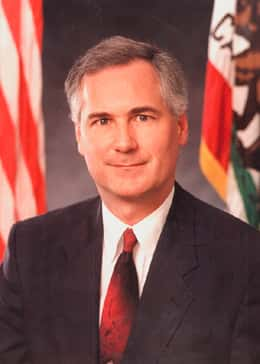 Governor Schwarzenegger—“The People’s Governor” as his official press release proclaims—spoke recently to the National Press Club and graciously offered our nation’s leaders some lessons from his successful “post-partisan” leadership in California. It’s an elegant concept, built upon the works of the great philosopher Rodney King when he posed the age-old question of human existence: “Can’t we all just get along?”
Governor Schwarzenegger—“The People’s Governor” as his official press release proclaims—spoke recently to the National Press Club and graciously offered our nation’s leaders some lessons from his successful “post-partisan” leadership in California. It’s an elegant concept, built upon the works of the great philosopher Rodney King when he posed the age-old question of human existence: “Can’t we all just get along?”
While modestly noting he didn’t claim to be Gandhi, the People’s Governor recounted the remarkable policy breakthroughs he’s achieved simply by inviting Democratic leaders to “come by, light up a stogie and schmooze.”
The National Press Club sat spellbound as Schwarzenegger described how he “schmoozed” California’s liberal Democrats into hiking the minimum wage into the stratosphere, embarking upon the biggest borrowing binge in state history and imposing the most draconian regulations in the country to save the planet from global warming.
Bipartisan compromises like these, wrought with barely any Republican votes, offer a model of the post-partisan utopia now forming on the Left Coast. As the governor explained, “After years of sharp divisions in California, we’re consciously trying a new approach to our problems.”
And that’s overdue. Just four years ago, amidst those sharp divisions, Californians recalled Governor Gray Davis after he’d nearly bankrupt the state with runaway spending that created the biggest budget deficit in California’s history. State government consumed a record $8.80 out of every $100 of personal income. That’s when Californians replaced Davis with a governor who promised to bring spending under control, “cut up the credit cards” and “live within our means.”
As he readily admits, Schwarzenegger made some mistakes at the beginning. He tried to restore spending controls, introduce operational reforms and curb the excesses of California’s powerful public employee unions. But, as he manfully confessed to the nation’s press corps, this only “contributed to the polarization.” It divided people and upset them—especially the public employee unions.
It was in this dark hour that our governor had an epiphany, which he brilliantly outlined in his second-term inaugural address. “It was amazing,” he told the Press Club. “It made news stories around the world. There’s such political division out there that, when someone simply talks about working together, it’s newsworthy.”
Today, California has no political divisions of which to speak. Government spending and the deficit are growing much faster than they did under Gray Davis…but everyone feels better about it.
That’s not to say there’s no opposition. A few pockets of “extremists” still lurk on the fringes of California politics, but as Schwarzenegger says, “Why is being principled reserved for extremists? Isn’t the ultimate principle to represent the people?”
Thus, the People’s Governor can claim to support “lower taxes and free markets and believe in the power of the individual,” while simultaneously proposing the second biggest tax increase in California’s history, imposing radical restrictions on commerce and enacting an unprecedented list of nanny laws.
After wowing the National Press Club, the People’s Governor provided a real-life demonstration of his new “post-partisan” leadership by bringing together the Democratic governors of Arizona, New Mexico, Washington and Oregon (very similar to the coalition he’s built in California) to announce a regional accord to combat global warming.
Sadly, the four Democratic governors made it clear they weren’t willing to adopt the radical global warming bill that post-partisanship has produced in California. Alas, even in our new post-partisan world, there are still limits to how far left the People’s Governor can go.



